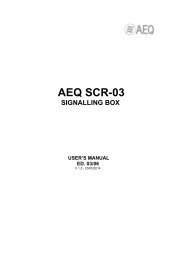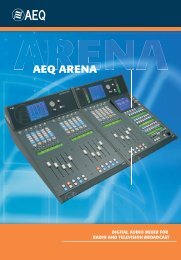Manual - AEQ International
Manual - AEQ International
Manual - AEQ International
You also want an ePaper? Increase the reach of your titles
YUMPU automatically turns print PDFs into web optimized ePapers that Google loves.
• In mic/line channels, indication of the position of the switching jumpers that selects thenominal level of the signal as mic or line (located inside the audio engine). It changesfrom “MIC” to “LINE” and vice versa when you change the jumpers position. See section“2.2.3.6 MIC/LINE inputs”.• In mic/line channels configured as mic, indication of the position of the Phantom powerswitching jumpers (located inside the audio engine). It changes from “PHANTOFF” to“PHANTON” and vice versa when you change the jumpers position. See section“2.2.3.6. MIC/LINE inputs”.The contextual keys under the display are associated with the three options shown in thebottom line of the screen:• “BACK”: pressing this key allows you to return to the previous menu screen.• “FADER”: allows you to assign another input channel to the physical fader where thissignal is currently found.• “ROUTE”: gives you acces to the menu for control and configuration of the internalrouting of the equipment.3.4.3.1.3.1. “FADER” menu.This submenu is displayed as a list of all the inputs available in the system (except the ones thatare yet assigned to a fader). You can make your selection by turning any of the associatedencoders and then pressing any of them or the “OK” contextual key to confirm the selection thatis highlighted at that moment.The “BACK” contextual key allows you to return to the previous menu screen without changedthe assigned signal.3.4.3.1.3.2. “ROUTE“ menu.From this internal submenu you can manage the internal routing of signals in the console. Youcan access from the advanced information menu of an audio input channel and that submenushows an alphabetical list of all of the outputs present in the console, followed by the internalsumming buses (“Program”, “Audition”, “Aux1” and “Aux2”), the monitoring buses (“Cue”,“Studio” and “Control”) and finally the MPX buses.The operation of the three associated encoders is as follows:• Left: turning this encoder allows you to scroll through the several audio outputs andbuses on the list. Pressing this encoder allows you to return to the previous menuscreen (the changes you may have made are saved).• Centre: turning this encoder has no associated function. Pressing this encoder allowsyou to return to the previous menu screen (the changes you may have made aresaved).• Right: turning this encoder enables you to modify the gain in the cross-point of thehighlighted output or bus between -99.8dB and +12dB. By default, all of the crosspointswill be configured with a 0dB gain. Pressing this encoder allows you to return tothe previous menu screen (the changes you may have made are saved).<strong>AEQ</strong> CAPITOLUltra-compact digital audio mixer49
















